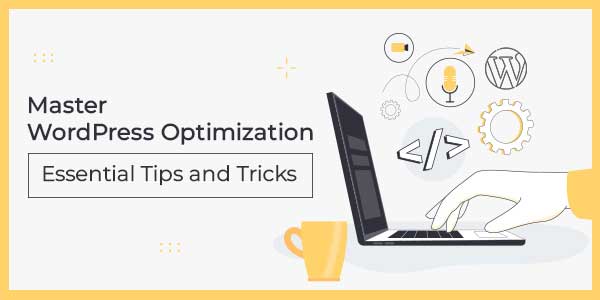
Imagine landing on a website that feels sluggish and unresponsive—odds are, you’ll leave before it even finishes loading. This is precisely why WordPress optimization is crucial. It transforms under-performing sites into fast, efficient platforms that improve user experience and enhance WordPress SEO. By focusing on WordPress speed optimization, businesses can ensure visitors can navigate content quickly, stay engaged, and reduce their chances of bouncing off their site.
But it’s not just about speed. When you invest in WordPress performance enhancements, you’re doing more than improving speed—you’re building a website that consistently delivers value, keeps users engaged, and ultimately drives growth for your business. By investing in WordPress performance enhancements, businesses can create a digital presence that not only attracts visitors but keeps them coming back for more. This blog will detail various critical aspects and nuances of WordPress optimizations to help you optimize your site the best.
Table of Contents
Understanding WordPress Performance Metrics:
When it comes to running a successful WordPress site, performance is everything. It will enhance both user experience and WordPress SEO. Consequently, it will ensure visitors stay engaged, and search engines like Google will reward you with higher rankings. This is where WordPress optimization plays a vital role.
The Critical Role of Website Speed in WordPress Performance:
Speed impacts more than just how fast a page loads—it directly influences your bottom line. A sluggish website can frustrate users, leading to higher bounce rates and lost sales. Conversely, a well-optimized site will load quickly across all devices, keeping users engaged, reducing abandonment, and ensuring that your website remains competitive. In terms of WordPress SEO, search engines prioritize fast-loading sites, so investing in speed optimization is crucial for maintaining high search visibility.
- User Experience: Users are more likely to abandon a website that takes too long to load. This can negatively impact user satisfaction, brand reputation, and conversions.
- Search Engine Rankings: Search engines also prioritize fast-loading sites when ranking results, making WordPress speed optimization essential for improving WordPress SEO.
Top Tools for Measuring WordPress Performance:
To maintain optimal WordPress performance, it’s important to continually monitor your site’s speed and efficiency. Tools like Google PageSpeed Insights, GTmetrix, and Pingdom offer deep insights into how well your site is performing. These tools provide detailed reports on load times, resource utilization, and other factors that affect speed, helping you pinpoint where WordPress optimization is needed most. Using these tools regularly allows you to stay ahead of performance issues and make informed adjustments that enhance both user experience and search rankings.
Here is a list of Key Performance Indicators (KPIs) to track:
- Page Load Time: How quickly a page fully loads impacts both user engagement and SEO.
- Time to First Byte (TTFB): The speed at which your server starts delivering content—crucial for performance.
- Render Blocking Resources: Delays caused by certain resources that slow down page rendering need to be minimized.
- Leverage Browser Caching: Ensuring repeat visitors benefit from cached resources can drastically improve load times.
- Minify Resources: Compressing CSS and JavaScript files reduces file size, speeding up load times and improving overall WordPress website optimization.
Core WordPress Optimization Techniques:
Several techniques for WordPress optimization deliver a smooth user experience. These include caching, minification, image optimization, and Content Delivery Networks (CDNs). These WordPress Optimization techniques can boost both WordPress speed optimization and SEO, leading to faster load times, improved user engagement, and better search engine rankings. Let’s break down the essential techniques for WordPress website optimization.
Caching: Accelerating WordPress Performance
Caching is one of the simplest yet most impactful ways to improve WordPress performance. By storing static versions of your website, caching reduces server load and accelerates page delivery. Whether you’re using page caching to store entire pages or database caching to speed up query responses, a caching solution is vital.
Recommended Caching Plugins for Efficient WordPress Optimization:
- WP Rocket: A premium caching plugin is known for its ease of use and powerful features.
- W3 Total Cache: A free caching plugin with extensive customization options.
- Fastly CDN: A powerful CDN solution that can improve website speed and performance.
Minification: Reducing File Size for Faster Loads
Minifying your CSS and JavaScript files is another critical step in WordPress speed optimization. Minification removes unnecessary characters like whitespace, comments, and line breaks, shrinking file sizes to help pages load faster.
Recommended Plugins:
- Autoptimize: A free plugin that offers both minification and concatenation of CSS and JavaScript files.
- WP Rocket: In addition to caching, WP Rocket also includes minification features.

Image Optimization: Speeding Up with Smaller Files
Large images can drastically slow down a website, affecting both load times and WordPress SEO. Compressing images without sacrificing quality is essential for improving performance. This not only boosts WordPress performance but also enhances the mobile experience, which is crucial for SEO.
Recommended Image Optimization Tools:
- TinyPNG: A free online tool that compresses PNG images.
- ImageOptim: A free macOS app for optimizing images.
- Smush: A popular WordPress plugin that automatically compresses images upon upload.
Content Delivery Network (CDN): Fast Global Delivery
A CDN takes your WordPress website optimization to the next level by distributing your content across multiple servers worldwide. This reduces latency by allowing users to access your site from a server near them, drastically improving load times. Several CDN providers offer fast and reliable content delivery, ensuring that no matter where your visitors are, they experience consistent speed and performance.
Recommended CDN Providers:
- Cloudflare: A popular CDN provider with a free plan that includes basic CDN features.
- Sucuri: A security-focused CDN provider that also offers performance optimization features.
- KeyCDN: A flexible CDN provider with a variety of pricing options and features.
Advanced WordPress Optimization Techniques:
Beyond the basics of WordPress optimization, several advanced technical optimization methods can dramatically improve WordPress performance. Techniques such as database optimization, plugin and theme management, and server configuration are crucial for ensuring your site runs efficiently. When implemented correctly, these advanced strategies will enhance your website’s speed, user experience, and WordPress SEO. Let’s explore these next-level tactics.
Database Optimization: Streamlining for Better Performance:
An overstuffed or disorganized database can bog down your site, affecting both WordPress speed optimization and overall functionality. Regular database maintenance is key to keeping things running smoothly.
- Indexing frequently queried columns can speed up searches.
- Query optimization ensures you’re fetching only necessary data, reducing server strain.
- Data cleanup—removing old revisions, spam comments, and unused content—can trim your database size and boost performance.
Plugins like WP-Optimize or Optimize Database After Delete automate this process, ensuring your database stays lean, which is vital for long-term WordPress website optimization.
Plugin and Theme Optimization: Choosing Wisely for Maximum Speed:
Not all plugins and themes are built the same. Lightweight, well-coded plugins and themes are essential for maintaining WordPress performance. Overloading your site with poorly maintained or unnecessary plugins will slow your load times and open you to security risks. By choosing optimized plugins and themes, you not only enhance WordPress performance but also ensure better WordPress SEO as your site becomes faster and more responsive.
- Deactivating Unnecessary Plugins: Deactivating or deleting unused plugins is a simple but effective step in WordPress optimization.
- Optimize Theme Code: Optimizing theme code—such as reducing unnecessary scripts or minimizing external HTTP requests—can further improve site speed.
Server Optimization: Powering WordPress with Efficient Configuration
Your hosting server plays a major role in WordPress website optimization. If your server isn’t properly configured, it can be a huge issue, slowing down even a well-optimized site. Here are some key areas to consider:
- PHP Settings: Adjust PHP settings like memory limits, execution time limits, and maximum file upload size to optimize performance. Consider upgrading to PHP 7+.
- Server Caching: Enable server-side caching mechanisms like opcode or full-page caching to improve response times. Varnish or Redis can improve the speed at which your website processes and delivers data.
- Resource Allocation: Ensure that your server has sufficient resources (CPU, memory, and storage) to handle your website’s traffic.
Conclusion:
As your site grows and new technologies emerge, maintaining WordPress website optimization is key to ensuring your site remains fast, secure, and user-friendly. Regular monitoring and updates help identify areas where performance might slip and ensure your site continues to deliver the seamless experience users expect. By embracing ongoing optimization, you’re not just improving today’s performance—you’re setting your website up for long-term success in a rapidly evolving digital landscape. Consistent optimization is what keeps your site relevant, competitive, and primed for growth.

 About the Author:
About the Author:
















Be the first to write a comment.